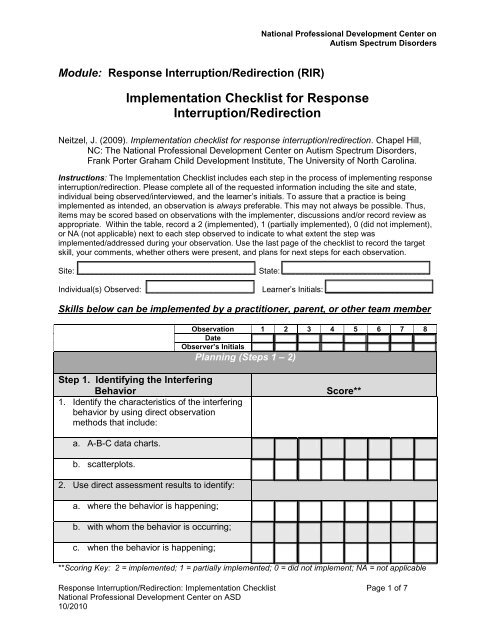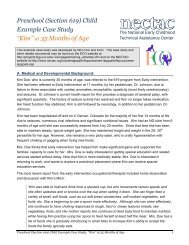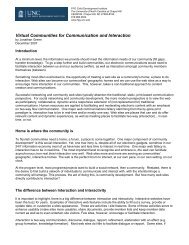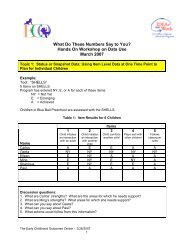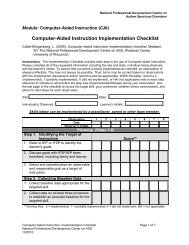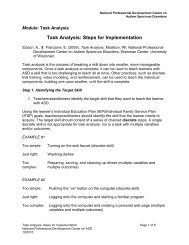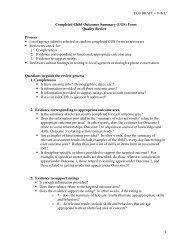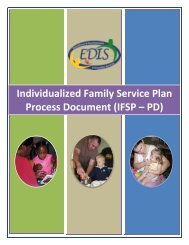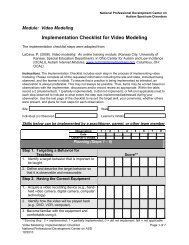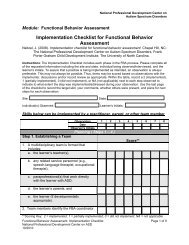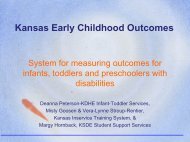Implementation Checklist for Response Interruption/Redirection
Implementation Checklist for Response Interruption/Redirection
Implementation Checklist for Response Interruption/Redirection
You also want an ePaper? Increase the reach of your titles
YUMPU automatically turns print PDFs into web optimized ePapers that Google loves.
National Professional Development Center on<br />
Autism Spectrum Disorders<br />
Module: <strong>Response</strong> <strong>Interruption</strong>/<strong>Redirection</strong> (RIR)<br />
<strong>Implementation</strong> <strong>Checklist</strong> <strong>for</strong> <strong>Response</strong><br />
<strong>Interruption</strong>/<strong>Redirection</strong><br />
Neitzel, J. (2009). <strong>Implementation</strong> checklist <strong>for</strong> response interruption/redirection. Chapel Hill,<br />
NC: The National Professional Development Center on Autism Spectrum Disorders,<br />
Frank Porter Graham Child Development Institute, The University of North Carolina.<br />
Instructions: The <strong>Implementation</strong> <strong>Checklist</strong> includes each step in the process of implementing response<br />
interruption/redirection. Please complete all of the requested in<strong>for</strong>mation including the site and state,<br />
individual being observed/interviewed, and the learner’s initials. To assure that a practice is being<br />
implemented as intended, an observation is always preferable. This may not always be possible. Thus,<br />
items may be scored based on observations with the implementer, discussions and/or record review as<br />
appropriate. Within the table, record a 2 (implemented), 1 (partially implemented), 0 (did not implement),<br />
or NA (not applicable) next to each step observed to indicate to what extent the step was<br />
implemented/addressed during your observation. Use the last page of the checklist to record the target<br />
skill, your comments, whether others were present, and plans <strong>for</strong> next steps <strong>for</strong> each observation.<br />
Site: ________________________________________ State: _________________________________<br />
Individual(s) Observed: ________________________ Learner’s Initials: ________________________<br />
Skills below can be implemented by a practitioner, parent, or other team member<br />
Observation 1 2 3 4 5 6 7 8<br />
Date<br />
Observer’s Initials<br />
Planning (Steps 1 – 2)<br />
Step 1. Identifying the Interfering<br />
Behavior<br />
1. Identify the characteristics of the interfering<br />
behavior by using direct observation<br />
methods that include:<br />
Score**<br />
a. A-B-C data charts.<br />
b. scatterplots.<br />
2. Use direct assessment results to identify:<br />
a. where the behavior is happening;<br />
b. with whom the behavior is occurring;<br />
c. when the behavior is happening;<br />
**Scoring Key: 2 = implemented; 1 = partially implemented; 0 = did not implement; NA = not applicable<br />
<strong>Response</strong> <strong>Interruption</strong>/<strong>Redirection</strong>: <strong>Implementation</strong> <strong>Checklist</strong> Page 1 of 7<br />
National Professional Development Center on ASD<br />
10/2010
National Professional Development Center on<br />
Autism Spectrum Disorders<br />
Module: <strong>Response</strong> <strong>Interruption</strong>/<strong>Redirection</strong> (RIR)<br />
Step 1. Identifying the Interfering<br />
Behavior (cont.)<br />
d. activities during which the behavior<br />
occurs;<br />
e. what other students are doing when the<br />
behavior starts;<br />
f. what teachers/adults are doing when<br />
the behavior starts;<br />
g. proximity to other students, teachers,<br />
and/or adults;<br />
h. the noise level in the environment;<br />
i. the number of individuals in the area;<br />
j. other environmental conditions; and<br />
k. the function of the behavior.<br />
3. Develop a hypothesis statement <strong>for</strong> the<br />
interfering behavior that includes:<br />
a. the setting events,<br />
b. a restatement and refinement of the<br />
description of the interfering behavior,<br />
and<br />
c. the function the behavior serves.<br />
4. Identify a more appropriate, alternative<br />
behavior to take the place of the interfering<br />
behavior.<br />
Observation 1 2 3 4 5 6 7 8<br />
Date<br />
Observer’s Initials<br />
Score**<br />
**Scoring Key: 2 = implemented; 1 = partially implemented; 0 = did not implement; NA = not applicable<br />
<strong>Response</strong> <strong>Interruption</strong>/<strong>Redirection</strong>: <strong>Implementation</strong> <strong>Checklist</strong> Page 2 of 7<br />
National Professional Development Center on ASD<br />
10/2010
National Professional Development Center on<br />
Autism Spectrum Disorders<br />
Module: <strong>Response</strong> <strong>Interruption</strong>/<strong>Redirection</strong> (RIR)<br />
Observation 1 2 3 4 5 6 7 8<br />
Date<br />
Observer’s Initials<br />
Step 2. Collecting Baseline Data<br />
Score**<br />
1. Measure a learners’ engagement in the<br />
interfering behavior be<strong>for</strong>e implementing<br />
RIR by collecting the following:<br />
a. frequency data,<br />
b. interval data, and<br />
c. duration data.<br />
2. Collect baseline data <strong>for</strong> a minimum of four<br />
days be<strong>for</strong>e implementing RIR.<br />
3. Collect baseline data in each setting/activity<br />
<strong>for</strong> four days.<br />
Step 3. Implementing RIR<br />
1. Praise the learner’s independent use of<br />
appropriate skills.<br />
2. When a learner begins to exhibit an<br />
interfering behavior, interrupt the learner’s<br />
attempts by using:<br />
a. physical blocking, and<br />
b. verbal blocking.<br />
3. For learners who engage in vocal<br />
stereotypies, redirect learners to use an<br />
identified alternative behavior by:<br />
a. saying the learner’s name in a neutral<br />
tone of voice,<br />
Intervention (Step 3)<br />
b. establishing eye contact, and<br />
**Scoring Key: 2 = implemented; 1 = partially implemented; 0 = did not implement; NA = not applicable<br />
<strong>Response</strong> <strong>Interruption</strong>/<strong>Redirection</strong>: <strong>Implementation</strong> <strong>Checklist</strong> Page 3 of 7<br />
National Professional Development Center on ASD<br />
10/2010
National Professional Development Center on<br />
Autism Spectrum Disorders<br />
Module: <strong>Response</strong> <strong>Interruption</strong>/<strong>Redirection</strong> (RIR)<br />
Step 3. Implementing RIR (cont.)<br />
c. asking a social question to prompt the<br />
learner to use an alternative<br />
vocalization.<br />
4. For learners who engage in motor<br />
stereotypies or self-injurious behavior,<br />
redirect them to engage in an identified<br />
alternative behavior by:<br />
a. saying the learner’s name in a neutral<br />
tone of voice,<br />
b. establishing eye contact with the<br />
learner with ASD, and<br />
c. using the system of least-to-most<br />
prompts to help the learner engage in<br />
the alternative behavior.<br />
5. For learners who engage in pica, redirect<br />
them to engage in an identified alternative<br />
behavior by:<br />
a. making a preferred food item freely<br />
available during times when pica is<br />
prevalent,<br />
b. saying the learner’s name in a neutral<br />
tone of voice,<br />
c. establishing eye contact with the<br />
learner with ASD, and<br />
d. using the system of least-to-most<br />
prompts to help the learner engage in<br />
the alternative behavior.<br />
Observation 1 2 3 4 5 6 7 8<br />
Date<br />
Observer’s Initials<br />
Score**<br />
**Scoring Key: 2 = implemented; 1 = partially implemented; 0 = did not implement; NA = not applicable<br />
<strong>Response</strong> <strong>Interruption</strong>/<strong>Redirection</strong>: <strong>Implementation</strong> <strong>Checklist</strong> Page 4 of 7<br />
National Professional Development Center on ASD<br />
10/2010
National Professional Development Center on<br />
Autism Spectrum Disorders<br />
Module: <strong>Response</strong> <strong>Interruption</strong>/<strong>Redirection</strong> (RIR)<br />
Step 3. Implementing RIR (cont.)<br />
6. After redirecting the learner with ASD to the<br />
alternative behavior, require the learner to<br />
engage in the alternative behavior <strong>for</strong> a<br />
specified period of time.<br />
7. Rein<strong>for</strong>ce the learner’s use of the<br />
alternative behavior.<br />
Step 4. Monitoring Learner Progress<br />
1. Use progress monitoring data to evaluate<br />
whether the interfering behavior is<br />
decreasing as a result of the intervention.<br />
2. Use progress monitoring data to evaluate<br />
the learner’s use of the alternative behavior<br />
in settings/activities where the interfering<br />
behavior typically occurs.<br />
3. Use progress monitoring data to adjust<br />
intervention strategies if the interfering<br />
behavior is not decreasing.<br />
Observation 1 2 3 4 5 6 7 8<br />
Date<br />
Observer’s Initials<br />
Progress Monitoring (Step 4)<br />
Score**<br />
**Scoring Key: 2 = implemented; 1 = partially implemented; 0 = did not implement; NA = not applicable<br />
<strong>Response</strong> <strong>Interruption</strong>/<strong>Redirection</strong>: <strong>Implementation</strong> <strong>Checklist</strong> Page 5 of 7<br />
National Professional Development Center on ASD<br />
10/2010
National Professional Development Center on<br />
Autism Spectrum Disorders<br />
Module: <strong>Response</strong> <strong>Interruption</strong>/<strong>Redirection</strong> (RIR)<br />
Date<br />
Observer<br />
Initials<br />
Target Skill/Behavior, Comments, and Plans <strong>for</strong> Next Steps<br />
Date<br />
Observer<br />
Initials<br />
Target Skill/Behavior, Comments, and Plans <strong>for</strong> Next Steps<br />
Date<br />
Observer<br />
Initials<br />
Target Skill/Behavior, Comments, and Plans <strong>for</strong> Next Steps<br />
Date<br />
Observer<br />
Initials<br />
Target Skill/Behavior, Comments, and Plans <strong>for</strong> Next Steps<br />
<strong>Response</strong> <strong>Interruption</strong>/<strong>Redirection</strong>: <strong>Implementation</strong> <strong>Checklist</strong> Page 6 of 7<br />
National Professional Development Center on ASD<br />
10/2010
National Professional Development Center on<br />
Autism Spectrum Disorders<br />
Module: <strong>Response</strong> <strong>Interruption</strong>/<strong>Redirection</strong> (RIR)<br />
Date<br />
Observer<br />
Initials<br />
Target Skill/Behavior, Comments, and Plans <strong>for</strong> Next Steps<br />
Date<br />
Observer<br />
Initials<br />
Target Skill/Behavior, Comments, and Plans <strong>for</strong> Next Steps<br />
Date<br />
Observer<br />
Initials<br />
Target Skill/Behavior, Comments, and Plans <strong>for</strong> Next Steps<br />
Date<br />
Observer<br />
Initials<br />
Target Skill/Behavior, Comments, and Plans <strong>for</strong> Next Steps<br />
<strong>Response</strong> <strong>Interruption</strong>/<strong>Redirection</strong>: <strong>Implementation</strong> <strong>Checklist</strong> Page 7 of 7<br />
National Professional Development Center on ASD<br />
10/2010


